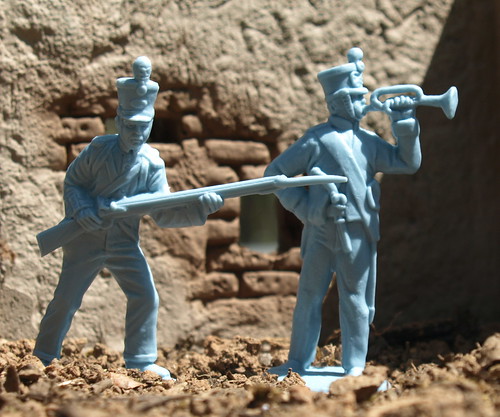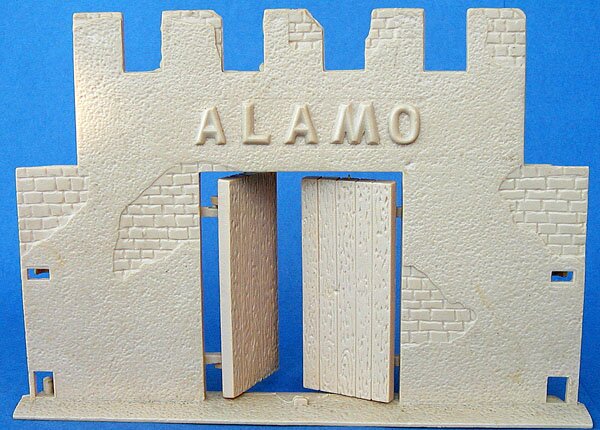 Legend also has it that no one survived the fight. In reality more than a dozen of the original two hundred lived including a black slave and many women and children. Santa Anna did not put them all under the sword as many of the rumors across the land stated.Usually the Alamo is looked at as the struggle to survive and stand against the “big dog”. But militarily it was a complete mistake and debacle. Travis refused to give up the mission for in his mind it was the key to winning the revolution. He had time to run for it and hole up somewhere stronger. But det
Legend also has it that no one survived the fight. In reality more than a dozen of the original two hundred lived including a black slave and many women and children. Santa Anna did not put them all under the sword as many of the rumors across the land stated.Usually the Alamo is looked at as the struggle to survive and stand against the “big dog”. But militarily it was a complete mistake and debacle. Travis refused to give up the mission for in his mind it was the key to winning the revolution. He had time to run for it and hole up somewhere stronger. But det ermination and pride was the ruler of the day.Texas belonged to Mexico and the Alamo was the sacrifice to achieve independence. The death of the famous men and the fall of the mission along with exaggerated tales of Santa Anna’s cruelty inspired the Texans and gave them the energy to fight harder and eventually win their independence.
ermination and pride was the ruler of the day.Texas belonged to Mexico and the Alamo was the sacrifice to achieve independence. The death of the famous men and the fall of the mission along with exaggerated tales of Santa Anna’s cruelty inspired the Texans and gave them the energy to fight harder and eventually win their independence.Enrique Della Pena is a main source. In 1955, a book of his memoirs of the battle was published. The memoirs are controversial in that they said that Davy Crockettdid not die fighting (as is the common belief), but instead surrendered (along with his Tennessee boys) during the battle of the Alamo and was later executed. Historians disagree on whether the memoirs are accurate. Was it a matter of good guys versus bad guys? Not really. It is in truth a story of men and women who were not quite the same as the ones who ruled and owned their land and wanted to rule themselves independently. In an effort to separate much blood was shed and the Alamo became a symbol to inspire a victory.
The Toluca Battalion joined the rest of Santa Anna's army in San Antonio on March 4, 1836, eleven days after the siege of the Texas garrison in the Alamo Mission had begun. Santa Anna launched an assault on the Alamo in the early hours of March 6.

the brilliant upnaway
Duque was assigned to lead one of the four assault columns, and he requested that de la Peña accompany him. De la Peña remained at the front until Duque fell wounded and then returned to the rear to find General Manuel Fernández Castrillón, second-in-command of that column.
At least twice more de la Peña returned to the front lines to accept or deliver messages. His only wound was a serious bruise.
After the Battle of the Alamo, de la Peña saw no further action.
However, he saw campaign action till the end of the Texas war, till he arrived in Matamoros, Mexico, by the beginning of June 6, 1836. After Santa Anna was captured at the Battle of San Jacinto, de la Peña retreated with the rest of the Mexican army back to Mexico, arriving in Matamoros on June 6, 1836.
The Zapadores Battalion had an unfilled slot for a captain, and de la Peña was soon promoted to take that position. For the next few months de la Peña requested letters of combat commendations from other officers for his heroic actions during the Texas campaigns, receiving ones from Lieutenant Colonel Ampudia, Duque, Lieutenant Colonel Amat, and even from General Jose de Urrea, who had not been part of the battle of the Alamo.
And all of them testified to his brave actions in the Alamo death fight, hence they all agreed to write recommendation affidavits testifying to De la Pena's brave conduct in the Alamo battle. In December 1836 de la Peña was in Mexico City, where he testified in the inquiry into the actions of General Vicente Filisola during the army's retreat from Texas.
Filisola was accused of being a coward for ordering the Mexican army to Matamoros when there was no reason to do so. He did this on orders from Santa Anna, who was a prisoner of the Texans! This action from BOTH these men is surely unnatural, NEVER performed anywhere else in world history; a general(Filisola) in the battlefield, obeying orders from his superior, who is a prisoner of the enemy!
During this time, de la Peña wrote a newspaper articles criticizing Filisola, which he signed "An Admirer of Texas". Filisola knew that de la Peña had authored the article and the following week published a counterattack, referring to de la Peña as "Peñita". De la Peña then published a very long article defending himself and further criticizing Filisola. His letters of commendation were published in conjunction with the article. The articles also mentioned that de la Peña had kept a diary during his time in Texas.
 BMC. Everyone hates them but they are really nice pieces in that you can easily convert them.
BMC. Everyone hates them but they are really nice pieces in that you can easily convert them. Marx Crockett set
De la Peña was promoted to lieutenant colonel by April 1837. That month, he was sent to Sonora, where he served under General Urrea.On January 7, 1838, de la Peña published a "fiery proclamation" exhorting his garrison in the District of Baroyecca to support liberty and Urrea.
The following week he issued a similar proclamation, published in El Cosmopolita in the town of Los Alamos.
De la Peña joined Urrea in an uprising to overthrow Santa Anna and restore the Constitution of 1824. While De la Pena was in Texas, fighting against the American invaders in North Mexico(Texas), he had kept a diary which was not published till 1955. It was located by J. Sanchez Garza, a fine researcher, and then presented to the world, when it was translated by DRT member, Ms. Carmen Perry.
After further research by Mr. Roger Borroel, a Texas researcher, known for his many discoveries of Mexican documents on the Texas War of 1836, it was found that De la Pena was murdered by a fellow Zapadores officer, Francisco Cosio, on October 10, 1840, at about 9pm, on a street corner in Mexico City. Further research by Mr. Borroel, revealed a pardon request by De la Pena's killer, in 1842.

Upnaways New Hope Design set see his website.
Alamo memoirs
While in prison, de la Peña wrote an article about some of his experiences fighting in Texas.
 marx alamo, yes it did have this name on the door written cactlee like this
marx alamo, yes it did have this name on the door written cactlee like this"If those in the cultured countries name us savages and assassins, none more than general Santa Anna has given an occasion to this. In the Alamo he ordered the murder of a few unfortunates who had survived the catastrophe, and whom general Castrillón presented imploring his mercy. Among those had been a man who pertained to the natural sciences, whose love of it had conducted him to Texas, and who locked himself up in the Alamo not believing it safe by his quality of foreigner, when general Santa Anna surprised [San Antonio]."
This article contained de la Peña's first mention of the execution of Texian survivors at the Alamo, but did not mention names of any of those executed and did not claim that de la Peña was an eyewitness. The article was never published and the original copies have been lost. Although a reprint survives, because of the lack of publication it is difficult to determine the authenticity of the documents. However, it's all we have, and they are all historically, realiable for use in historic studies on the subject.
 marx
marxIn 1955, Jesús Sanchez Garza published a book called La Rebellion de Texas—Manuscrito Inedito de 1836 por un Ofical de Santa Anna purporting to be de la Peña's memoirs. Inedito means "unpublished" in Spanish, meaning that this was the first time the memoirs were publicly available.
Garza self-published the book, which included the diary, 40 pages of introductory material on de la Peña and an additional 90 pages of supporting documents, including the only known copy of the article de la Peña wrote from prison.
The book had little impact on historical research into the Alamo as it had only a limited printing in Spanish in Mexico, and many researchers did not know it existed.
In 1975 the Texas A&M University Press published an English translation of the book, called With Santa Anna in Texas: A Personal Narrative of the Revolution. The English publication caused a scandal within the United States as it asserted that Crockett did not die in battle. Historians disagree on whether any or all of the book has been faked.[10][12] Because the original book was self-published, no editor or publisher ever vetted its authenticity.[13] Garza never explained how he gained custody of the documents or where they were stored after de la Peña's death.[14] Nor did he need to, for all of De la Pena's statements have been verified by other Mexican sources.
Some historians, including Bill Groneman, found it suspicious that Garza's compilation was published in 1955, at the height of interest in Crockett and the Alamo caused by Walt Disney's television series about Crockett's life. Groneman also points out that the journals are made up of several different types of paper from several different paper manufacturers, all cut down to fit.[14] Historian Joseph Musso also questions the validity, also basing his suspicions on the timing of the diaries' release.
However, James Crisp, a history professor from North Carolina State University, has studied the papers and is convinced they are genuine. However, all disputes have been settled in this regard for in October 2001, in a Southwestern Historical Quarterly article, Dr. David B. Gracy II, and his science team, have proven beyond all doubt that De la Pena's work is authentic in every way, ink, paper, and truth. The original manuscript, consisting of 200 loose pages, was auctioned in 1998 for $387,500. It now resides at the Center for American History at the University of Texas at Austin.
No comments:
Post a Comment